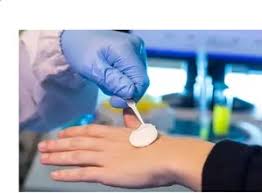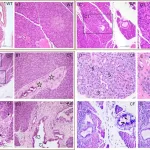In a groundbreaking study, researchers have identified a skin-derived compound, Corynebacterium tuberculostearicum (C. tuberculostearicum), a bacterium commonly found on human skin, which could potentially combat hyperpigmentation. This discovery holds promise for safer, non-toxic treatments in the cosmetic industry.
Melanin, a pigment produced by melanocytes, protects the skin from the harmful effects of ultraviolet (UV) radiation. The production of melanin is stimulated by UV exposure, with the enzyme tyrosinase playing a critical role in this biosynthetic pathway. Disruptions in this pathway can lead to hyperpigmentation, a condition characterized by darkened skin patches.
To address hyperpigmentation, tyrosinase inhibitors that suppress melanin synthesis have been sought after in the cosmetic industry. However, some of these compounds, such as hydroquinone, have been found to be toxic, causing adverse effects like vitiligo-like symptoms and rashes. Consequently, hydroquinone is no longer recommended for use, prompting the search for safer alternatives.
The increasing demand for non-toxic tyrosinase inhibitors has led researchers to explore natural sources, including microbes that produce low-toxicity compounds. A recent study led by Assistant Professor Yuuki Furuyama from the Department of Applied Bioscience at Tokyo University of Science (TUS), published in the International Journal of Molecular Sciences on July 4, 2024, has made significant strides in this direction.
“Bacteria that reside on our skin and evade immune responses often become commensals, neither benefiting nor harming us. We chose to investigate metabolites produced by these commensal bacteria for their potential as tyrosinase inhibitors. These natural skin-derived products exhibit low toxicity, making them inherently safer,” explained Dr. Furuyama.
After screening over 100 skin-derived bacteria, the research team identified C. tuberculostearicum as a producer of a potent tyrosinase-inactivating compound. Their assays utilized tyrosinase from the mushroom Agaricus bisporus to confirm inhibition. Subsequent experiments pinpointed the active compound as cyclo(L-Pro-L-Tyr).
“Our goal was to understand how cyclo(L-Pro-L-Tyr)—a compound that blocks melanin production and reduces skin dark spots—disrupts tyrosinase activity,” Dr. Furuyama stated. “Our findings revealed that cyclo(L-Pro-L-Tyr) mimics L-Tyr—an amino acid that helps produce melanin in the skin—by binding to and obstructing the substrate-binding pocket of mushroom tyrosinase. This interference renders the enzyme inactive.”
The study highlights the potential of cyclo(L-Pro-L-Tyr) as a skin probiotic for hyperpigmentation. The compound’s non-toxic nature, combined with its antimicrobial, antioxidant, and anticancer properties, offers a promising avenue for safer cosmetic treatments.
As the research community continues to explore the benefits of skin-derived compounds, the discovery of cyclo(L-Pro-L-Tyr) marks a significant step forward in the quest for effective and safe treatments for hyperpigmentation.











